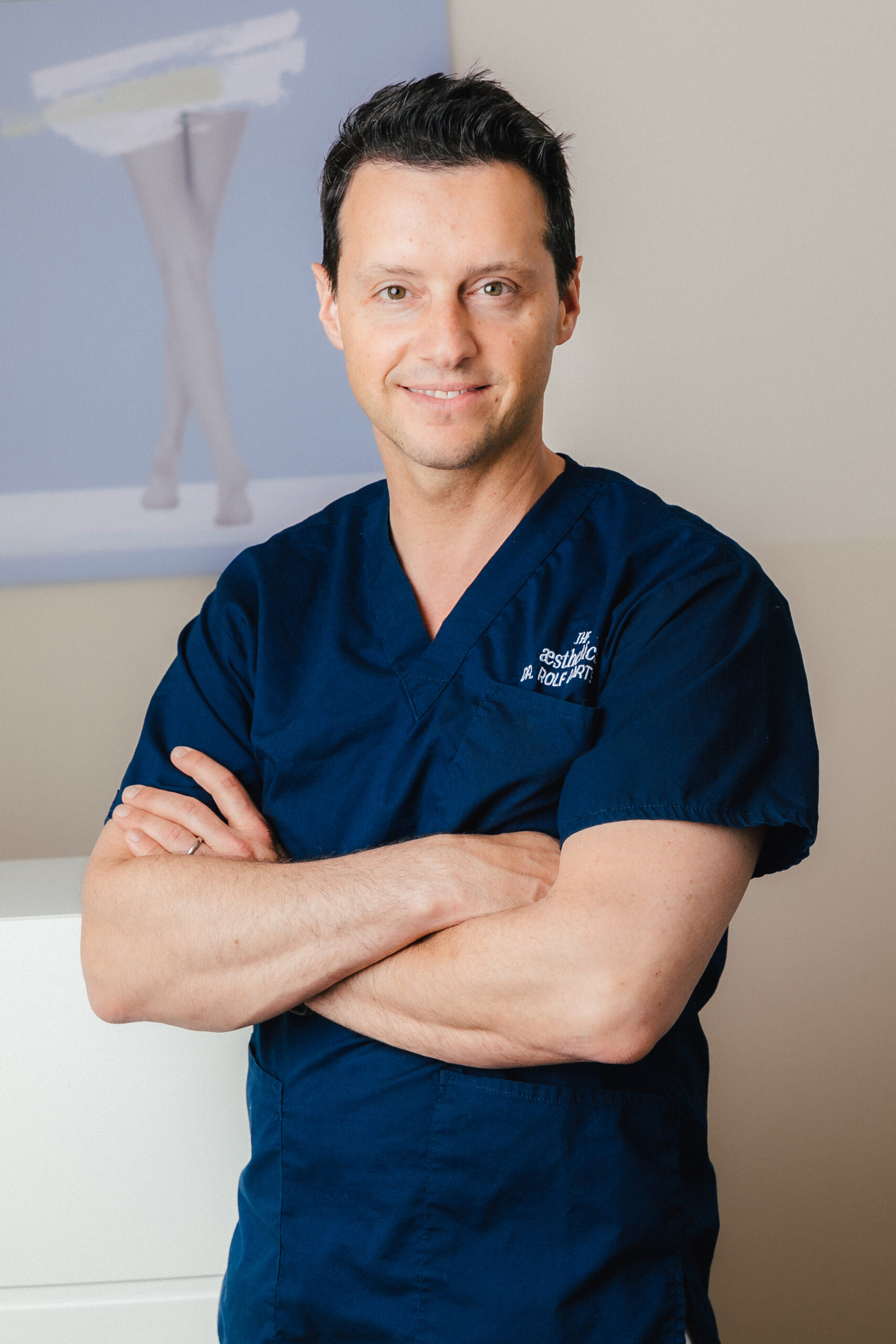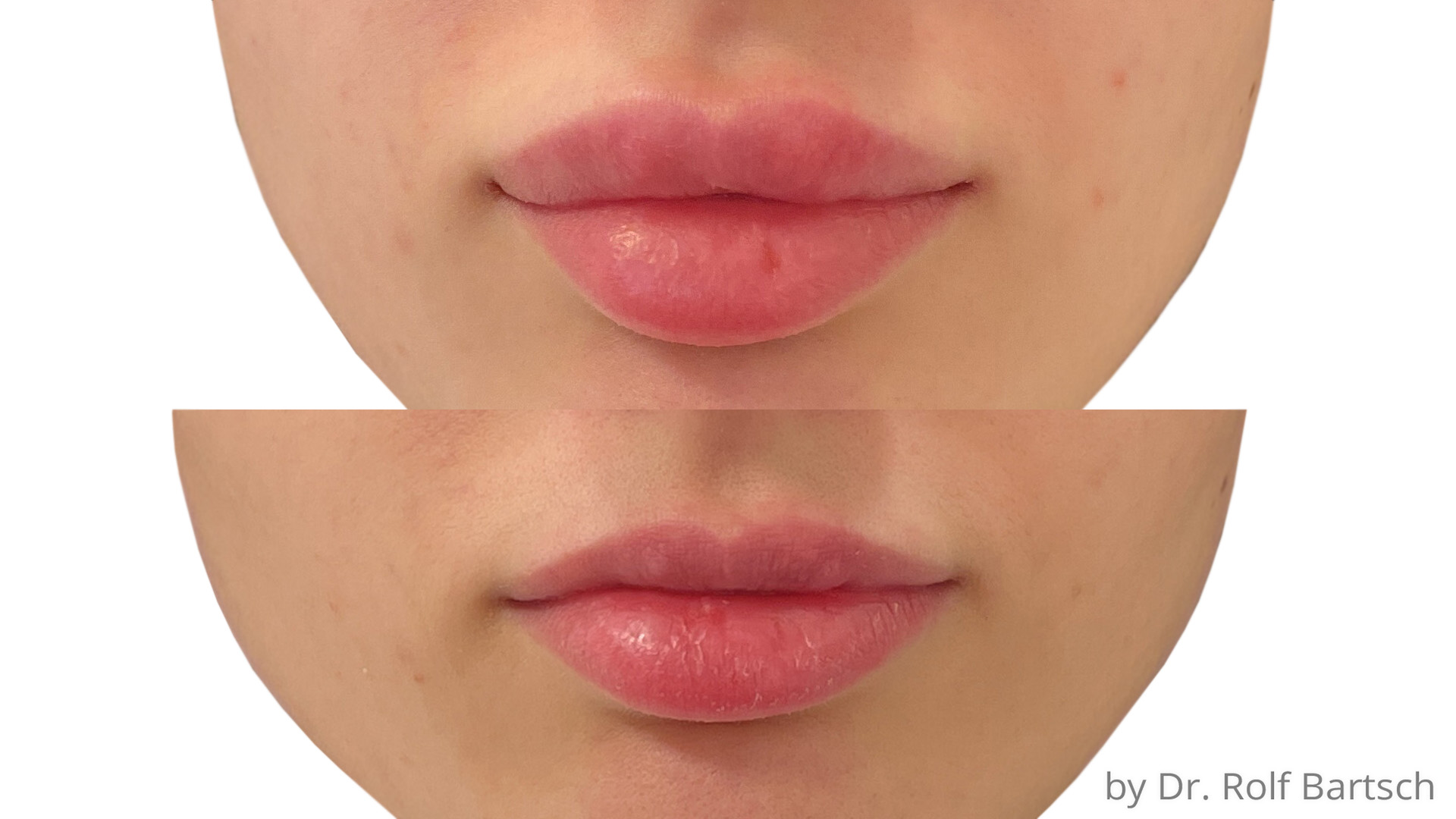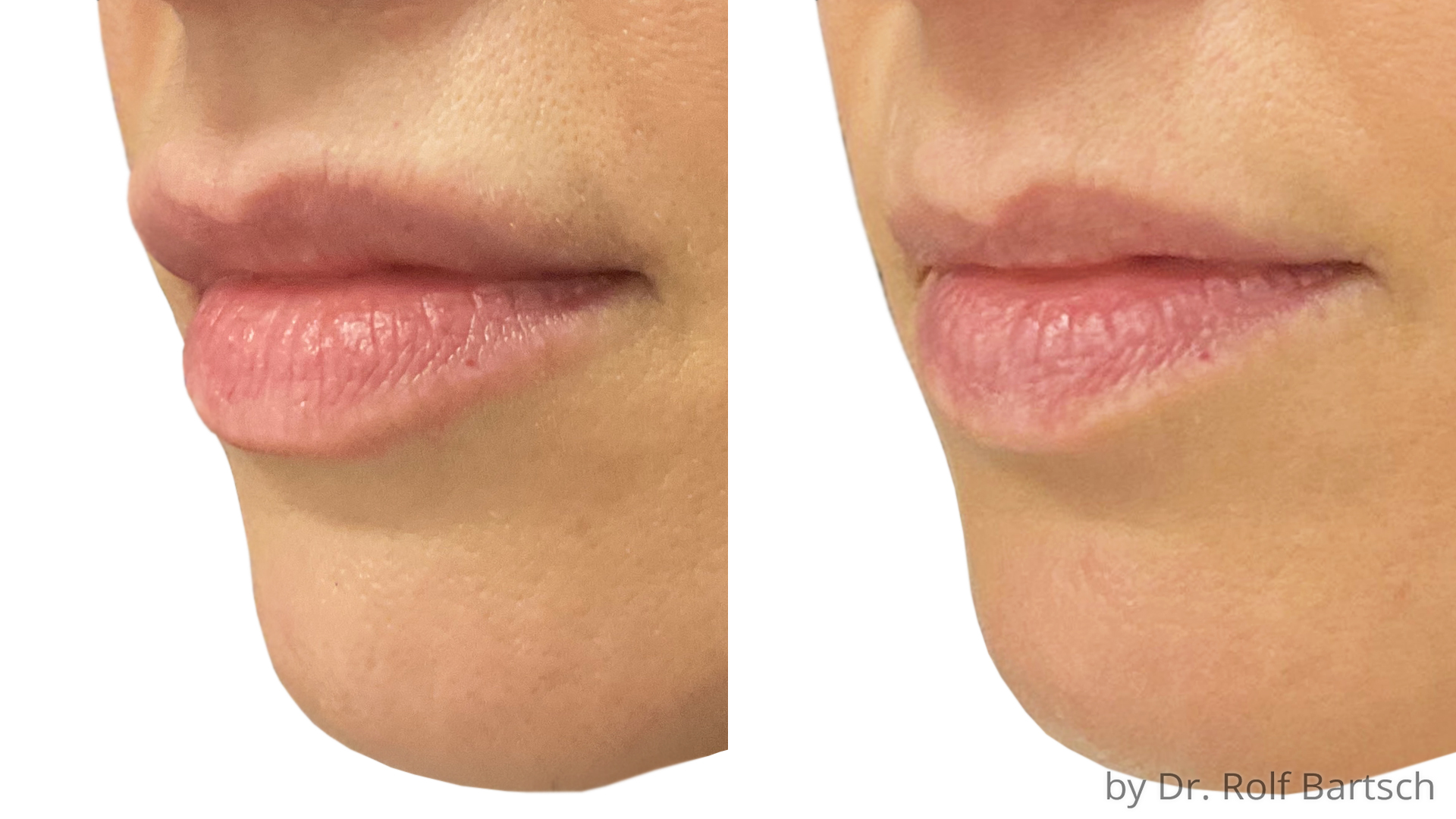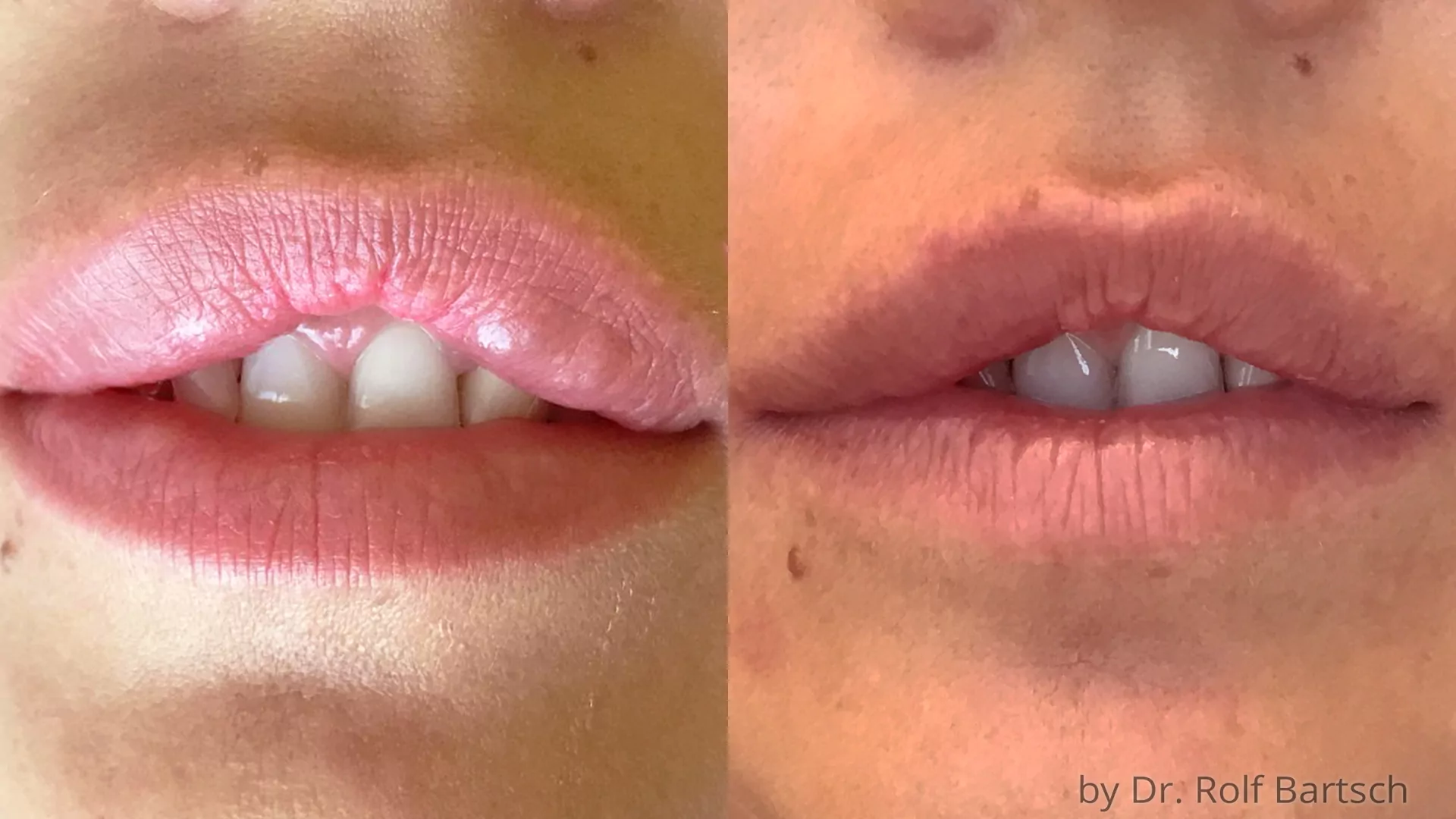- Plastic surgeryFaceMenuDekolettéMenuBodyMenu
- Aesthetic treatmentsFaceMenuDekolettéMenuBodyMenu
- Before After
- Ask the team
- Blog
- About
- For doctors
- Contact
- Team
KEY
FACTS
TECHNIQUE
Injection
INTERVENTION TIME
10-20 Minutes
PAIN
1-2 (Scale 1-10)
DOWNTIME
none
RESULT
immediately
COSTS
€ 500,- Initial consultation for new patients: € 70,-
PAYMENT
Advance bank transfer, cash or card payment possible.
ATTENDING
DOCTORS

Certified Injector


Certificate
Certificate for outstanding performance
Docify awards to
Dr. Rolf Bartsch
the
Award for the most patient votes Top 10 2021
Hylase – Hyaluronidase
Do you want a normal lip shape, without lumps, bulges or pain? Our solution: Hylase to dissolve hyaluronic acid in the lip or other areas of the face.
MAKING LIP INJECTION RECOVERABLE
Injections with hyaluronic acid have become very common in recent years. Besides corrections of temples, cheeks, cheekbone or chin, especially “injecting lips with hyaluronic acid” has become a very common treatment. Injections with hyaluronic acid usually proceed without complications, but in rare cases problems can occur. A distinction is made between short-term and long-term problems after hyaluronic acid injections:
SHORT-TERM PROBLEMS after HYALURON injections – these occur a few hours after the injection
- Bruising – hematoma
- Swelling
- Pain
- Dislocation – filler has “slipped”
- Vascular occlusion
LONG-TERM PROBLEMS after HYALURON injections – these occur weeks to years after the injection.
- Swelling and nodule formation
- Granulomas
- Dislocation – filler has “slipped”
SHORT-TERM PROBLEM – BLEEDING
Unfortunately, bruising and hematomas after injections cannot be 100% ruled out. It is important that the patient has not taken any blood thinning medication. In addition to necessary permanent medication for blood thinning, especially medications with the ingredient acetylsalicylic acid should be avoided at least 10 days before a treatment. Most bruises and hematomas, however, are caused by treatment with needles. Therefore, for many years we have been using mainly techniques with blunt needles – so-called cannulas. In this way, bruises can be better avoided and there is usually no downtime after a filler treatment. If a bruise does occur, creams containing heparin can help.
SHORT-TERM PROBLEM – SWELLING AND PAIN
Both swelling and pain are closely related to bleeding under the skin. If these are prevented, swelling and pain are also rare after hyaluronic treatments. High-quality products also no longer have the typical behavior of retaining water in the body, which also causes swelling. Modern hyaluron products from reputable manufacturers also contain a lidocaine powder, which often makes the treatment almost painless.
SHORT-TERM PROBLEM – DISLOCATION – THE FILLER HAS “SLIPPED OUT OF PLACE
If hyaluronic acid was injected into the mucosa instead of the lip body, this can lead to lumps, bumps, bumps and, above all, pain. Likewise, there is a possibility that the result of a previous treatment may not be what the patient wants. With a substance called Hylase, there is a possibility of dissolving the gel – if it is hyaluronic acid – regardless of the manufacturer.
SHORT-TERM PROBLEM – VESSEL CLOSURE
This complication requires a professional approach by a competent physician or by a specialized department of a clinic. The signs of vascular occlusion can often be mistaken for a hematoma. The skin area appears marbled and there is often pain in the affected area. In the worst case, the filler that was injected into the vessel can also travel to the vessel that supplies the retina. Unfortunately, there are more and more cases of blindness after filler injections. This serious complication must be treated in a specialist ophthalmology department, because in addition to blood-thinning medication, hylase in particular must be injected behind the eyeball. Do I now as a doctor, and therefore my patients, have to be afraid of such a complication every day. The answer is “no”. With careful handling of the products, knowledge of the anatomy and a lot of experience, this complication is very, very rare.
LONG-TERM PROBLEM – SUSPENSION AND NODULATION
You have had a treatment with fillers a few weeks and months ago and now new swellings and nodules are forming? If everything was fine at the beginning after the treatment and suddenly new swellings and nodules appear, this can be a delayed T-cell reaction. This is an immune response that can often be triggered by trivial infections caused by other viruses such as flu viruses. Some fillers are more prone to these reactions. The first measure in this case is not so much Hylase, but much more a combination treatment of cortisone and an antihistamine.
LONG TERM PROBLEM – GRANULOMAS
Granulomas are painful nodules after filler treatments they increase in size and change. These rare complications have thankfully become rare with modern fillers. If it is a granuloma, often only surgical removal is the solution to the problem
LONG TERM PROBLEM – DISLOCATION – THE FILLER IS “DISLOCATED”
One of the reasons why the Austrian Society for Plastic, Reconstructive and Aesthetic Surgery fought for a ban on permanent fillers many years ago is that they usually cause problems due to “dislocation”. A filler injected in the right place today may end up in the wrong place 5 years from now, even with proper technique. The aging process changes the volume and consistency of the tissue. As a result, permanent fillers may then no longer be in the right place and you may feel that the filler has slipped.
If BIOPOLYMER has been injected into your lips, this plastic must be surgically removed. You can find more information about this here.
WHAT IS HYLASE?
Hylase, also called hyaluronidase, is an enzyme for dissolving hyaluronic acid. The product converts cross-linked hyaluronic acid into a liquid, water-like mass. Used by experienced physicians, it can correct problems such as bulges, bumps and general “overspray” after a hyaluronic acid treatment.
WHAT HAPPENS DURING A HYLASE TREATMENT?
A Hylase treatment is performed with a very thin needle that is injected directly into the hyaluronic acid product. Within a few hours, the hyaluronic acid dissolves. Depending on the treatment region, the injection may be more or less painful. For example, if the lip is being treated, it may be slightly larger in the short term.
HOW MUCH DOES A HYLASE TREATMENT COST?
Hylase is marketed in ampoules in powder form. Different concentrations – such as 150mg, 300mg or 1,500mg – need to be diluted differently. Up to 150-300mg can be used per treatment. The cost of one treatment at theaesthetics is €500.-
Experience is particularly important in this treatment, as Hylase dissolves any hyaluronic acid, including the body’s own. Therefore, the dosage and exact application must be determined precisely.
DOES HYLASE ALSO DISSOLVE THE BODY’S OWN HYALURONIC ACID?
Hylase is a very potent agent that should only be carefully dosed by an experienced physician. This enzyme is also capable of dissolving the body’s own hyaluronic acid – but since there is a constant and natural build-up and breakdown of hylauronic acid every day, the balance is redressed.
Solution in steps
FIRST CONSULTATION
You can reach us for an appointment for an initial consultation in several ways:
The ordination by phone: +4313535555
The ordination by mail: office@theaesthetics.at or via the Contact form
Dr. Rolf Bartsch personally via Messenger: +4369911222000
Why Dr. Bartsch?
We always say: “the gut feeling must be right”. Let your instincts guide you. But there are also hard facts that can make a potential decision easier for you:
- Knowledge: Dr. Katrin Bartsch and Dr. Rolf Bartsch have already performed more than 10,000 injections in over 12 years.
- Safety: Knowing the anatomy, structure and aging processes of the lip are key to success. We also pass on our knowledge to colleagues – www.fillertraining.at
- Availability: You can also reach our doctors personally in urgent cases:
Dr. Rolf Bartsch – 0699 11 222 000, Dr. Katrin Bartsch 0664 146 8585



